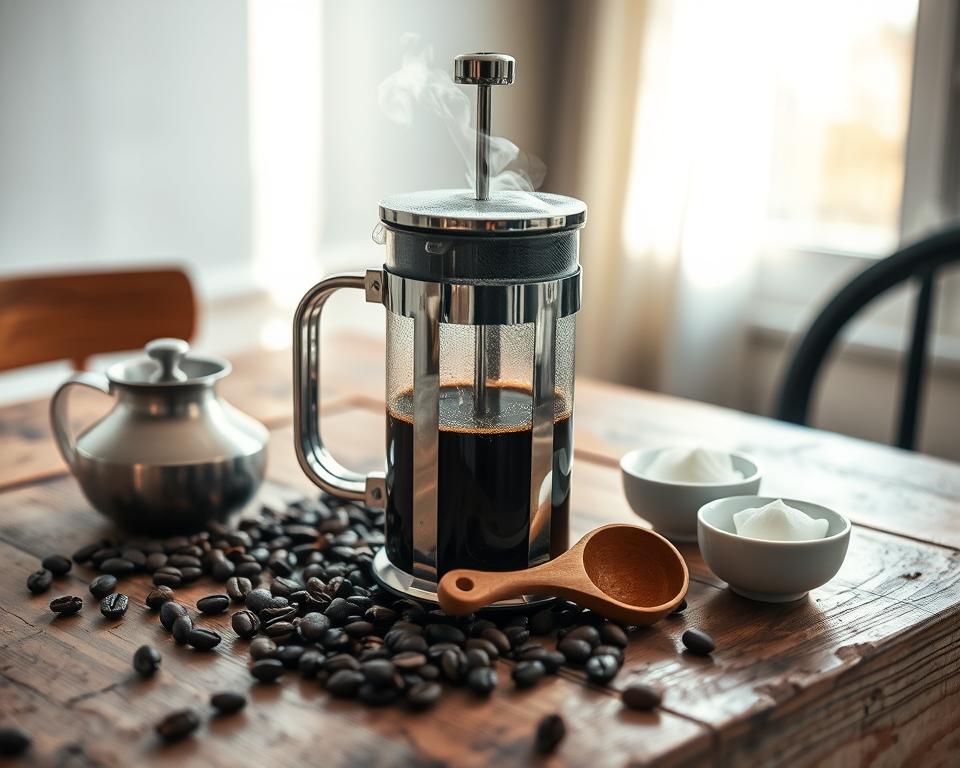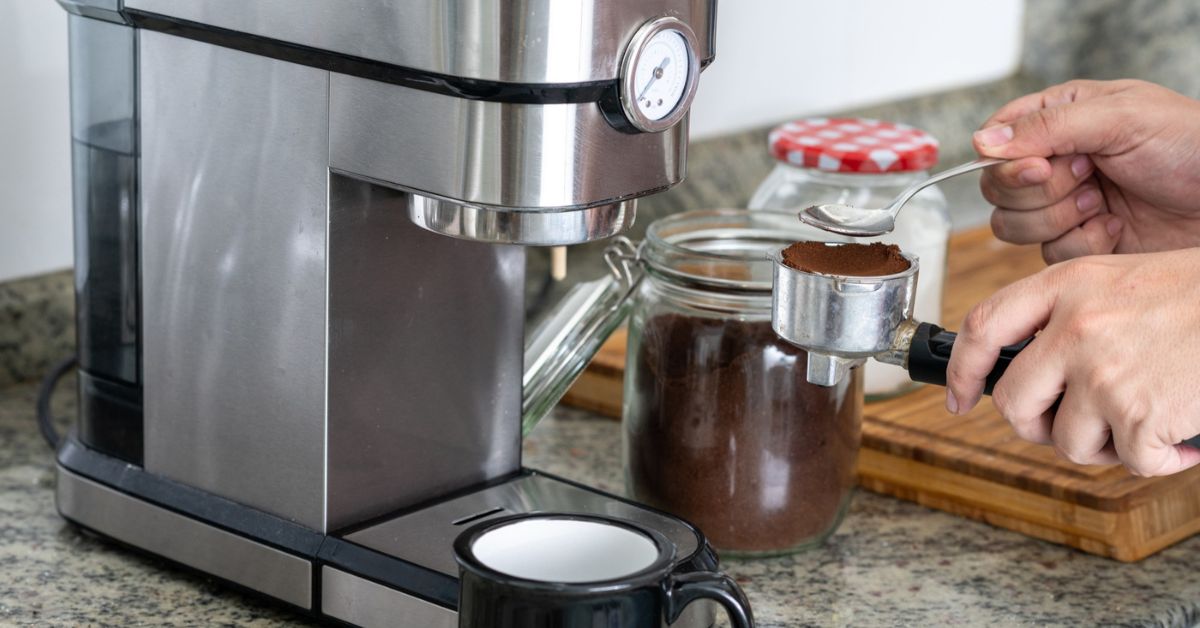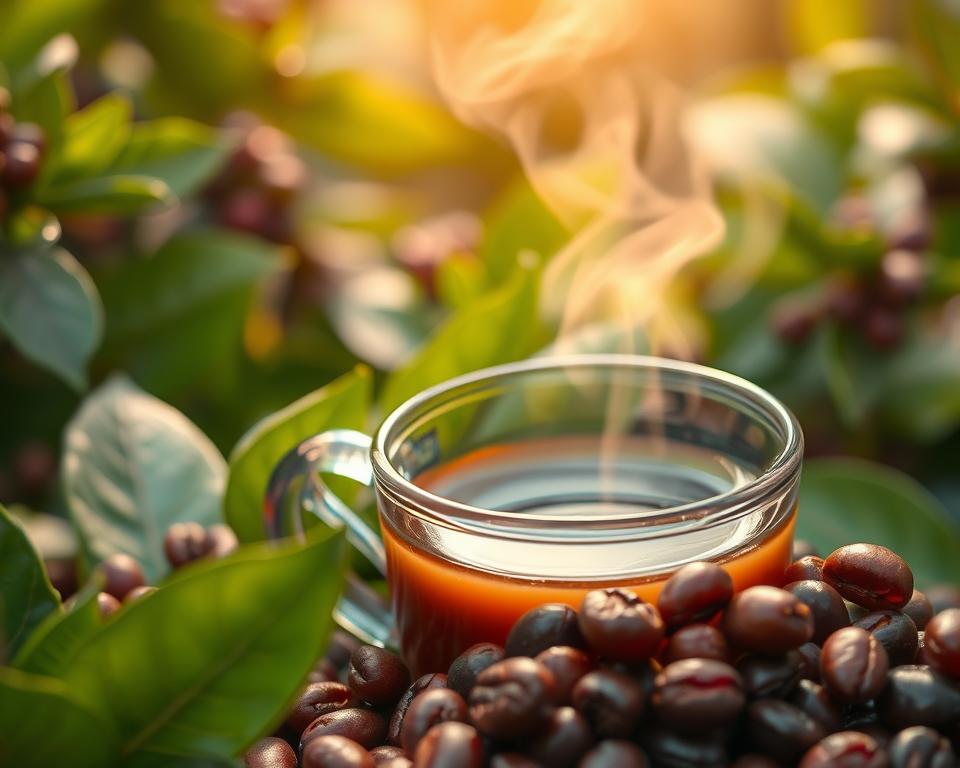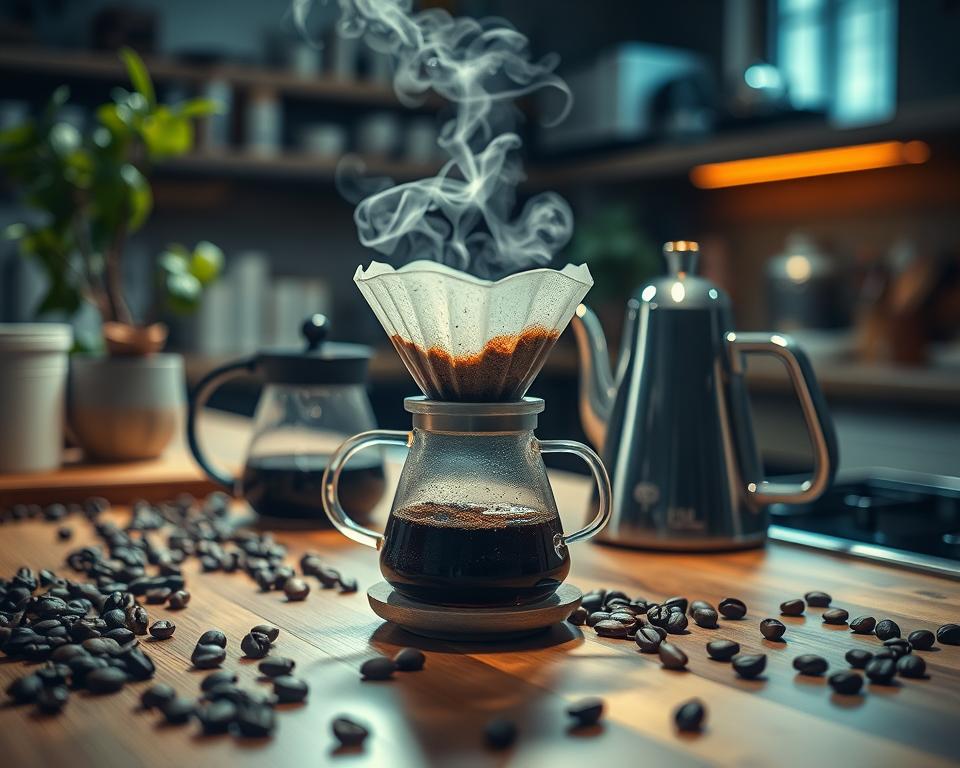The French press is famous for making rich, full-bodied coffee simply. The perfect cup depends on good beans, the right water temperature, and the coffee-to-water ratio. Most prefer a 1:15 ratio, which means using 15 grams of water for every gram of coffee. This ratio can change to fit how you like your coffee.
To make great French press coffee, use 30 grams of coarse coffee with 450 milliliters of water. Keep the water at about 200 degrees Fahrenheit to avoid a bitter taste. Brew for 4 minutes to get the best flavor.
A coarse grind size is key for French press coffee. It works well with the French press filter and stops over-extraction. This grind size helps make a perfect French press coffee cup.
Why Grind Size Matters for French Press Coffee
Understanding the ideal grind size is crucial for exceptional French press coffee. It’s about the extraction process that requires the right grind size. This ensures the best flavors come out.
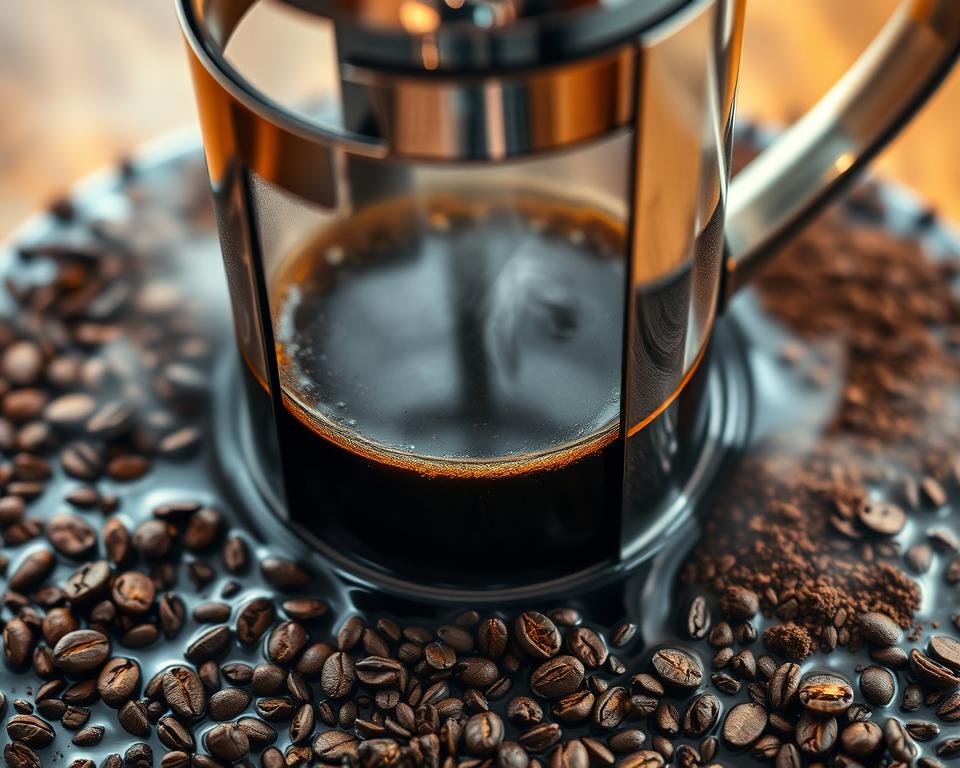
Impact on Flavor
The grind size greatly affects French press coffee’s flavor. If the beans are ground too fine, you get a bitter taste because the brew over-extracts. On the other hand, if the grind is too coarse, your coffee will be weak and watery.
The best grind size is like coarse sea salt. This helps release complex flavors and oils. Thus, you get a robust, full-bodied cup.
Avoiding Over-Extraction and Sediment
Getting the grind size right is key to avoiding over-extraction and sediment. Over-extraction makes the coffee too bitter. This happens with fine grounds. A coarse grind slows the extraction, balancing the flavors.
Furthermore, a coarser grind reduces sediment in your cup. This means your coffee will be cleaner and have less residue.
How to Achieve the Best Grind Size for French Press
Getting the perfect coarse grind for French press coffee is about knowing the right size. It also means choosing the right equipment. The grind’s quality greatly affects the flavor and texture of your coffee.
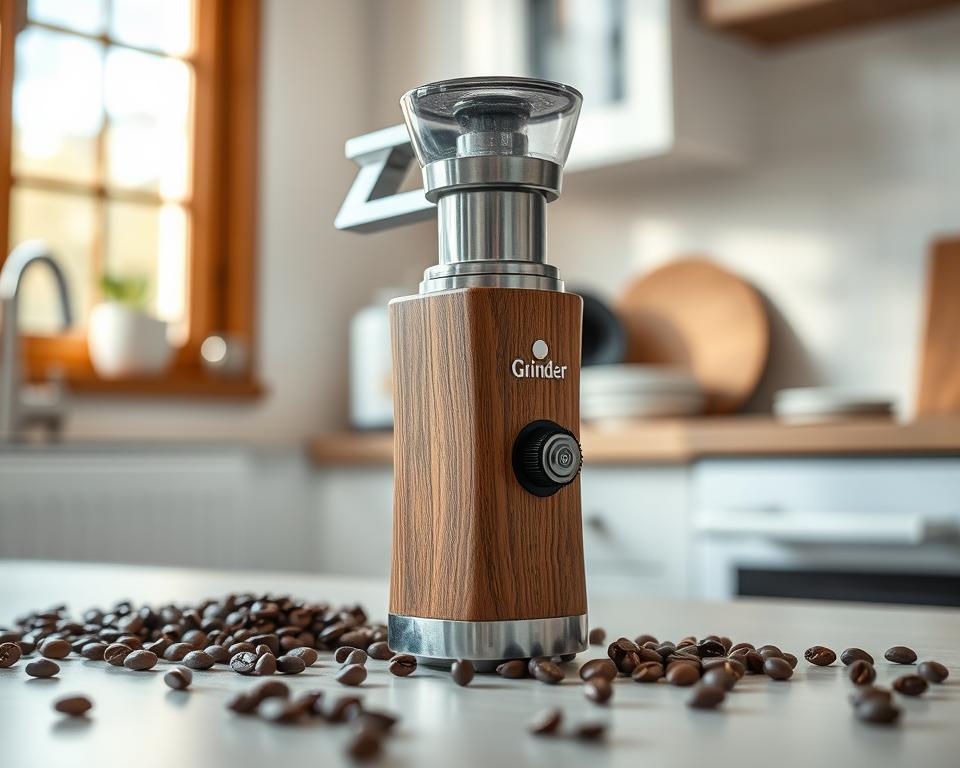
Using the Right Equipment
To get a consistent grind for French press, go for a burr grinder. Blade grinders often make uneven particles, messing up the extraction. Burr grinders give you an even grind size. This helps you get the coarse grind that’s best for French press. The ideal grind looks like breadcrumbs or coarse sea salt. It leads to better extraction and a cleaner coffee cup.
Coarse Grind Explained
A coarse grind is key for French press coffee. It stops over-extraction, which makes coffee bitter, and keeps grounds out of the mesh filter. Aiming for a uniform grind size matters a lot. It brings out the right flavor and less sediment in your coffee. Coarsely ground coffee is about 30% soluble. Yet, the best brews often have an 18-22% solubility. This brew is rich and full of flavors and aromas. It highlights the beans’ essence without any bitterness from over-extraction.
Choosing Coffee Beans for French Press
Choosing the right coffee beans for your French press is very important. You need to think about how fresh the beans are, what sort of roast they have, and where they come from. These factors play a big role in how your coffee will taste.
Freshness and Roast Level
You always want to use freshly roasted coffee beans for the French press. The fresher the beans, the more flavors and smells you’ll get in your coffee. It’s best if you use the beans a few weeks after they have been roasted. Medium-dark roasts are the best choice. They give you strong flavors that go great with the French press, making your coffee rich and full-bodied.
Single-Origin vs. Blends
When picking coffee beans, decide between single-origin beans or blends. Single-origin beans give you specific tastes that show where they come from. They can give you a really special and different coffee experience. If you like your coffee to have a stable flavor, then blends might be for you. Blends mix beans from various places to make a smooth taste. Both choices can affect how much you enjoy your French press coffee.
Step-by-Step Guide to Grinding Coffee for French Press
To make a perfect French press coffee, start by measuring the right amount of coffee. For a 1-liter French press, use 3-4 tablespoons. A single-serve press, about 350ml, needs 1 tablespoon. Stick to a 1:15 coffee-to-water ratio for the best taste.
Heat your water to 195-205 degrees Fahrenheit. While it heats, start grinding your coffee. Use a burr grinder for a coarse grind. The grounds should look like small breadcrumbs, about 690-1300 microns. This size is key for ideal extraction without bitterness.
Before brewing, warm up your French press with hot water. This keeps the temperature stable. Then, throw out the water and add your coffee grounds. Begin the bloom by covering the grounds with a bit of hot water. Let it sit for 45 seconds. This step helps release gases and ensures even extraction.
After the bloom, add the rest of the water. Stick to the 1:15 ratio. Stir gently to mix everything well. Put the plunger on top without pressing down, and wait for 4 minutes. This time allows the coffee to steep properly. Then, press down slowly and pour your coffee right away to avoid over-extraction.
By sticking to these steps, you’ll get better at making French press coffee. Keep practicing, and you’ll enjoy the perfect cup every time.
Common Mistakes and How to Fix Them
Even seasoned coffee lovers can slip up when making French press coffee. Knowing the common mistakes and fixing them is key to better brewing.
Too Fine Grind
Using too fine a grind is a big mistake with French press coffee. It often leads to a muddy and bitter cup due to over-extraction. To fix this, grind your beans to a coarse level. A burr grinder is best for getting the right size, about 30-40 on the STARESSO Discovery II Grinder scale. This change can make your coffee taste much better.
Inconsistent Grind Size
Inconsistent grind size is another issue. It causes uneven extraction, mixing bitter and sour tastes in your coffee. Keeping grind size uniform is crucial. Clean your grinder regularly and don’t fill the bean hopper too much to maintain consistency. For more improvement tips, check out this guide. Achieving consistency helps prevent many French press coffee mistakes.
Does the Grind Size Affect the Flavor of Cold Brew Made in a French Press?
The grind size significantly influences the flavor of cold brew made in a French Press. A coarser grind allows for a smoother taste, while a finer grind can lead to more bitterness. To truly master the art of cold brew extraction, experimenting with grind sizes is essential for achieving the desired flavor profile.
Conclusion
Learning to use a French press right involves knowing a few key parts well. Each step, from picking the best coffee beans to the grind size, is crucial. This ensures you get that ideal cup of coffee. The core of great French press coffee is controlling the grind size. It hugely affects the coffee’s flavor and body. A coarse grind helps avoid clogs and makes extraction smooth.
Getting the coffee-to-water ratio right is just as crucial. For a 4-cup French press, using 27 grams of coffee with a 1:12 ratio is best. Yet, you can change these ratios to suit your taste. It’s also vital to use water heated to about 200° Fahrenheit for the best results. If you’re new to this, start with 1 tablespoon of coffee per 4 cups of water as a basic guideline.
Understanding grind size is not only for French press users. It’s necessary for all brewing methods. For example, espresso needs a finer grind to avoid bad extraction, leading to sour or bitter tastes. Each way to brew coffee requires a different grind size. This affects the coffee’s flavor and body in various ways. Using burr grinders to get a consistent grind size also helps make your brew better.
To sum up, making perfect French press coffee isn’t just about a set recipe. It requires a deep understanding and control over each step. From selecting top-notch beans like those from Balance Coffee or Assembly Coffee to adjusting grind size for perfect extraction. Paying attention to these details guarantees a deeply satisfying coffee every time. If you’re keen to learn more about coffee nuances, including caffeine content, check out this link. Enjoy your brewing journey!
FAQ
What is the recommended coffee-to-water ratio for French press coffee?
For French press coffee, use a 1:15 ratio. That’s 15 grams of water for each gram of coffee. It means about 30 grams of coarsely ground coffee for 450 milliliters of water.
Why is the grind size important for French press coffee?
The grind size greatly impacts the coffee’s taste and texture. A coarse grind prevents a bitter flavor by avoiding over-extraction. It also stops ground coffee from spoiling the brew’s smoothness.
How can I achieve the perfect grind size for my French press?
A burr grinder gives you the right consistency, key for French press coffee. Look for a grind size like coarse sea salt.
What type of coffee beans should I use for French press brewing?
Use fresh beans for the best taste. Medium to dark roasts are best for French press. They bring out a strong flavor that suits this brewing method well.
What water temperature should I use for brewing French press coffee?
Use water between 195-205 degrees Fahrenheit. This temperature extracts flavors well without burning the coffee.
Why is it important to use a coarse grind for French press coffee?
A coarse grind stops over-extraction and bitterness. It also makes sure grounds don’t slip through the mesh filter.
How long should I let my French press coffee steep?
Steep your coffee for about 4 minutes. This time is perfect for full flavor without over-extracting.
What are the common mistakes to avoid when making French press coffee?
Don’t use a grind that’s too fine as it leads to bitter coffee. Also, avoid an uneven grind size for consistent extraction. A burr grinder helps get the right grind size.
How can I fix a bitter or weak French press coffee?
For bitter coffee, go for a coarser grind. If your coffee is weak, check the coffee-to-water ratio. Also, make sure your grind size is even.

